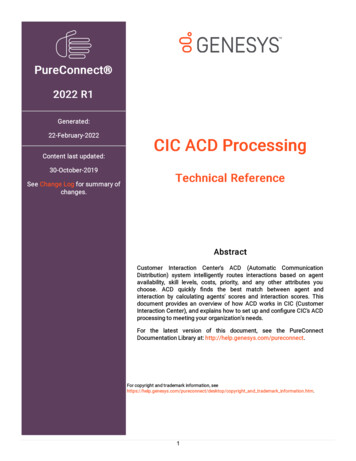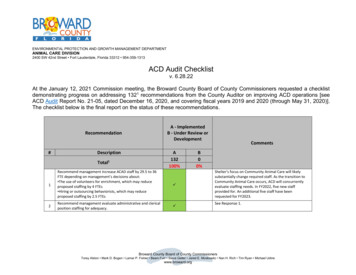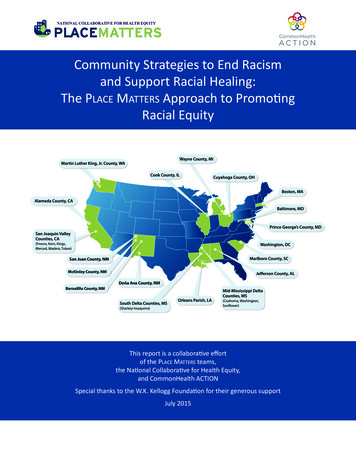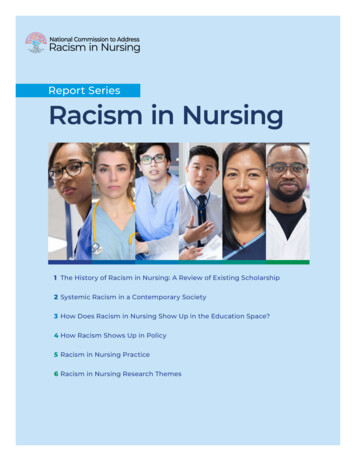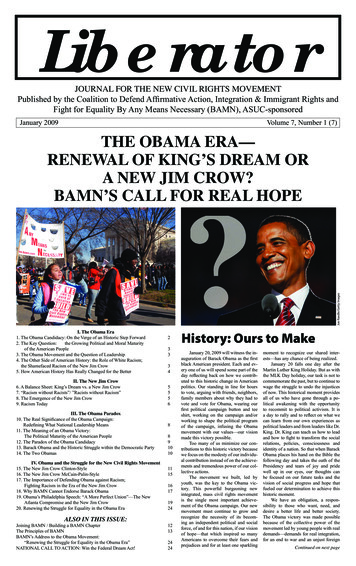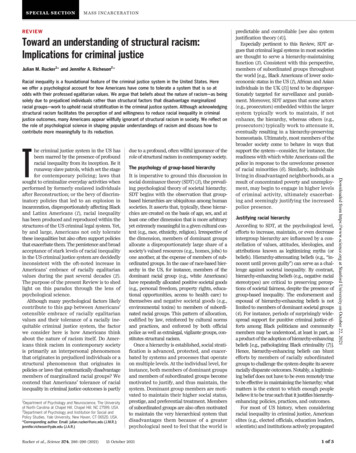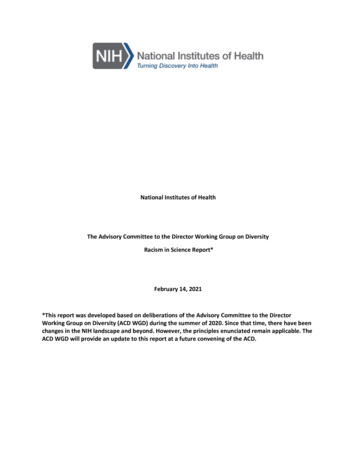
Transcription
National Institutes of HealthThe Advisory Committee to the Director Working Group on DiversityRacism in Science Report*February 14, 2021*This report was developed based on deliberations of the Advisory Committee to the DirectorWorking Group on Diversity (ACD WGD) during the summer of 2020. Since that time, there have beenchanges in the NIH landscape and beyond. However, the principles enunciated remain applicable. TheACD WGD will provide an update to this report at a future convening of the ACD.
Advisory Committee to the Director Working Group on DiversityMembershipStanley Andrisse, Ph.D., M.B.A.Assistant Professor, Department of Physiologyand Biophysics, Howard University College ofMedicine, and Adjunct Assistant Professor,Department of Pediatric Endocrinology, JohnsHopkins MedicineEdwin J. Barea-Rodriguez, Ph.D.Associate Dean for Student Success andInstructional Innovation and Professor ofNeurobiology, University of Texas at SanAntonioSteven Barnett, M.D.Director, National Center for Deaf HealthResearch; Program Director, Rochester Bridgesto the Doctorate; and Professor, Departmentsof Family Medicine and Public Health Sciences,University of Rochester School of Medicine &DentistrySherilynn J. Black, Ph.D.Associate Vice Provost for Faculty Advancementand Assistant Professor of the Practice ofMedical Education, Duke UniversityMarkus Brauer, Ph.D.Professor, Department of Psychology andWisconsin School of Business, University ofWisconsin–MadisonHealani K. Chang, Dr.P.H.Research Associate Specialist, PacificBiosciences Research Center, and AffiliateFaculty, Center for Teaching Excellence, Officeof Faculty Development and Academic Support,University of Hawai'i at MānoaJon Freeman, Ph.D.Associate Professor of Psychology and NeuralScience, New York UniversityGeorge C. Hill, Ph.D.Former Vice Chancellor and Chief DiversityOfficer for Equity, Diversity, and Inclusion; LeviWatkins, Jr. Distinguished Professor Emeritus,Medical Education; and Professor Emeritus,Pathology, Microbiology, and Immunology,Vanderbilt UniversityHilda Hutcherson, M.D., M.S.Senior Associate Dean, Office of Diversity andMulticultural Affairs, Vagelos College ofPhysicians and Surgeons, Columbia UniversityCalvin Lai, Ph.D.Assistant Professor of Psychological and BrainSciences, Washington University in St. LouisRae Nishi, Ph.D.Independent Senior Research and EducationScholar, Falmouth, MassachusettsFlorastina Payton-Stewart, Ph.D.Associate Professor, Department of Chemistry,and Faculty Administrative Fellow for Diversityand Inclusion, Office of Academic Affairs, XavierUniversity of Louisiana, and Adjunct Professor,Pharmacology Department, Tulane UniversitySchool of MedicineVijay Pendakur, Ed.D.Former Robert W. and Elizabeth C. Staley Deanof Students, Cornell UniversityIris L. Romero, M.D.Dean for Diversity and Inclusion and Professorof Obstetrics and Gynecology, University ofChicago MedicineNelson Sanchez, M.D.Associate Professor of Clinical Medicine, WeillCornell Medicine, and Urgent Care Physician,Memorial Sloan Kettering Cancer Center2
Robert M. Sellers, Ph.D.Vice Provost for Equity and Inclusion, ChiefDiversity Officer, and Charles D. MoodyCollegiate Professor of Psychology, University ofMichiganExecutive SecretarySiobhan Wescott, M.D., M.P.H.Assistant Professor and Assistant Director,Indians into Medicine, University of NorthDakota School of Medicine & Health SciencesEx Officio MembersTalithia Williams, Ph.D.Associate Professor of Mathematics andAssociate Dean for Research and ExperientialLearning, Harvey Mudd CollegeAlison Gammie, Ph.D.Director, Division of Training, WorkforceDevelopment, and Diversity, National Instituteof General Medical Sciences, National Institutesof HealthCo-ChairsMarie A. Bernard, M.D.Acting Chief Officer for Scientific WorkforceDiversity, Office of the Director, and DeputyDirector, National Institute on Aging, NationalInstitutes of HealthM. Roy Wilson, M.D.President, Wayne State UniversityHannah Valantine, M.D., MRCP, FACCFormer Chief Officer for Scientific WorkforceDiversity, Office of the Director, NationalInstitutes of HealthNicole LangHealth Program Specialist, Office of ScientificWorkforce Diversity, National Institutes ofHealthNoni Byrnes, Ph.D.Director, Center for Scientific Review,National Institutes of HealthP. Kay Lund, Ph.D.Director, Division of Biomedical ResearchWorkforce, Office of Extramural Research,National Institutes of HealthKaren L. Parker, Ph.D., M.S.W.Director, Sexual & Gender Minority ResearchOffice, Division of Program Coordination,Planning, and Strategic Initiatives, NationalInstitutes of HealthWilliam T. Riley, Ph.D.Associate Director for Behavioral and SocialSciences and Director, Office of Behavioral andSocial Sciences Research, National Institutes ofHealth3
Executive SummaryRacism is a dark yet prevalent aspect of life in the United States. It has unfortunately shaped manysystems and standards in our country, such as health care, employment, housing, income, and jobopportunities, creating countless inequities for underrepresented groups (URGs), which include racialand ethnic minorities, women, individuals with disabilities or underlying health conditions, andindividuals from disadvantaged backgrounds.* Systemic racism in the United States has particularlyaffected Black people. The ongoing coronavirus disease 2019 (COVID-19) pandemic and several recenthigh-profile incidents of police brutality against Black people have elevated the visibility of America’smany issues relating to systemic racism and inequity. These events have led to a call for a variety ofinstitutions to assess and address behaviors and practices that contribute to structural and culturalracism. The scientific workforce has not been immune from the effects of systemic racism and inequity:there is strong evidence that Black members of the scientific workforce have more difficulties beinghired for faculty positions, securing funding, and dealing with the demands of working in environmentswith low diversity. These difficulties can ultimately affect their success and retention in the scientificworkforce.This report provides suggestions by the Advisory Committee to the Director Working Group on Diversity,developed during the summer of 2020, about how the National Institutes of Health (NIH) can addressracism in the scientific workforce and improve diversity, equity, and inclusion (DEI) efforts. The first stepis acknowledging racism and inequity in the scientific workforce and thereby indicating support for Blackand other members of URGs in the scientific community. Next, the scientific community needs to use itsstrengths and conduct evidence-based research to better understand racism in the workforce anddevelop and evaluate interventions. Institutions need to closely monitor acts of racial discrimination andaddress them consistently and seriously. Institutions should also implement a variety of evidence-basedDEI trainings. While the scientific community should focus on efforts to promote individual-levelawareness and change regarding systemic racism, there also needs to be a significant effort to createinstitutional and cultural change. The focus should be on addressing recruitment, hiring, admission,retention, training, and funding processes and policies that negatively affect Black individuals and otherpeople from URGs. The scientific community needs to make a strong and expedited commitment toaddressing racism in order to create lasting change.ThemeAcknowledge Racismand Inequity andProvide Support toBlack Members of theScientific CommunitySuggestions Acknowledge the prevalence of racism and anti-Blackness in thescientific workforceOpenly discuss the impact of systemic racism and inequity on BlackscientistsPresent research with honest and precise language about racial andethnic disparitiesProvide personal- and institutional-level support for Black membersof the scientific community*Notice of NIH’s Interest in Diversity (NOT-OD-20-031)4
ThemeSuggestionsConduct Research toUnderstand SystemicRacism in ResearchStudies and theScientific Workforce Monitor Acts of RacialBias and Change theCulture SurroundingDiversity, Equity, andInclusion Make StructuralChanges to Mitigatethe Impact of Racismand Implicit Bias in theScientific Workforce Research potential interventions to address systemic racism inresearch studies and the scientific workforceLeverage cross-disciplinary and community-based research toenhance the diversity of researchers and participantsIncrease funding for health disparity and community-based researchUpdate funding applications to include criteria for external validityand best practices for enhancing diversityIdentify institutional practices that bolster systemic racism andimplement changesMonitor incidents of racial discrimination at institutions to ensureprogress and lasting changeEncourage scientific community members and others at NIH-fundedinstitutions to report incidents of bias and mistreatment (via periodicclimate surveys, real-time reporting, etc.)Implement targeted trainings and behavioral interventions to combatimplicit biasEmpower scientific community members to be allies to colleaguesfrom URGs by actively combatting racial discriminationCreate and enhance training and career pathway programs thatencourage students from URGs to pursue degrees and jobs in science,technology, engineering, and mathematics (STEM)Create incentives for institutions to enhance representation anddiversity through training programs and community-basedpartnershipsImplement trainings and standards for admissions and hiringcommittees to mitigate the impact of racism and implicit biasCreate annual DEI reporting requirements for researchers andinstitutions funded by NIH5
IntroductionRacism is an enduring issue in the United States. While there are people who have racist beliefs,whether malicious or unintentional, racism is embedded in many local and national systems, such ashealth care, education, income, and criminal justice.1 Systemic racism has created many inequities forpeople from underrepresented groups (URGs), especially Black people, and the events of 2020 have ledto a renewed call to address racism in all facets of American life. The coronavirus disease 2019 (COVID19) pandemic has severely impacted racial and ethnic minorities in the United States, with the highestdeath tolls due to COVID-19 among Black populations.2-4 Black people are more likely to have underlyingconditions, and there are historical systemic issues that have contributed to these disparities ininfection, hospitalization, and death rates among Black people due to COVID-19.5-7 For example, Blackpeople are more likely to have essential jobs, such as grocery store or warehouse workers, rely on publictransportation, and live in poor, crowded housing conditions, all of which increase the risk for beingexposed to COVID-19.5, 7 Additionally, recent events of police brutality directed at Black Americans haveaccentuated the depth of individual and systemic racism in our country. While police brutality againstBlack people is not novel, there have been several high-profile incidents of police violence that havesparked protests and calls for reform.The colliding events of the COVID-19 pandemic and ongoing police brutality have caused many appealsfor institutions to re-evaluate how their practices and beliefs contribute to systemic racism anddiscrimination. These inequities are well-established in many institutions, including the broaderscientific workforce. Many members of the scientific community have called for change to bettersupport Black scientists and enhance diversity.8-11 Within the scientific workforce, there are pervasiveinequities, such as discriminatory recruiting and hiring practices, the lack of diversity, fewer funding andpromotion opportunities for researchers from URGs, and embedded discrimination in the scientificresearch process. Each of these issues have contributed to a culture of racism and created challenges formembers of the scientific workforce from URGs.The National Institutes of Health (NIH) has long recognized the importance of diversity in the biomedicaland behavioral research workforce. The Advisory Committee to the Director (ACD) Working Group onDiversity (WGD) is a permanent working group of the ACD that has been charged with providing regularadvice to the ACD, which in turn advises the NIH Director on effective strategies to enhance diversity.These include efforts to improve the representation of URGs in the research workforce and to reducedisparities in research awards to applicants from URGs.† In response to revitalized calls for people andinstitutions to address racism in the United States, the ACD WGD reflected on its impact in the scientificworkforce. This report provides the ACD WGD’s suggestions about how NIH can address these issuesand promote systemic change. The evidence and suggestions presented in this report are based onpresentations and discussions during ACD WGD meetings on June 10 and August 11, 2020, andmembers’ written responses to questions about these issues. This report can be used to influence theimmediate and long-term actions of NIH and the scientific community to provide support to Black andother historically underrepresented racial and ethnic minority members of the scientific workforce,implement new initiatives, and elicit fundamental change.†NIH awards are made to institutions, but for the purposes of this report, the terms “applications” and “awards”refer to those senior and key personnel on applications and/or awards, respectively.6
Racism in the Scientific WorkforceThere is strong evidence that individuals from URGs face many challenges when finding jobs andexcelling in their careers, including in the scientific workforce. Despite improvements in recent years,the representation of people from URGs at the undergraduate, graduate, postdoctoral, and facultylevels remains significantly lower than in the U.S. population. This lack of diversity can negatively affectthe ability of individuals from URGs to be admitted into a graduate program or receive postdoctoral orfaculty positions. Similar disparities exist in NIH funding of scientists from URGs; although the number oftrainees from URGs receiving NIH funding has increased in recent years, these numbers are stilldeficient. This lack of funding can negatively affect an investigator’s research, hinder their careerprogress, and affect their retention in the workforce. Although NIH is dedicated to supporting allresearchers from URGs, recent events have highlighted the deeply rooted systemic racism against Blackpeople in particular, emphasizing the need to address challenges for Black scientists in the scientificworkforce.Racial and Ethnic Composition of the Scientific WorkforceAlthough efforts by NIH and other institutions to promote diversity have led to a steady increase in thenumber of students from URGs who receive bachelor’s and doctorate degrees in science andengineering, the demographics of the scientific workforce do not reflect the racial and ethnic diversity inthe United States.12, 13 Between 2012 and 2017, the number of Black doctoral recipients rose by almost29%.14 Despite this increase, only 22% of all science and engineering bachelor’s degrees and 9% of alldoctorate degrees were earned by students from URGs, even though people from URGs representedapproximately one third of the U.S. population.12 In 2016, Black men and women made up 4% and 7%,respectively, of the graduate student population in science and engineering programs.12 Within thescientific workforce, Black scientists represented only 7.7% of the full-time scientists, even though Blackpeople represent 13% of the U.S. population.12 The lack of diversity in the scientific workforce coulddiscourage individuals from URGs from pursuing a science degree or a faculty position and create anegative culture for current scientific workforce members from URGs. Faculty from URGs have reportedfeeling isolated or excluded since few or none of their colleagues look like them.13, 15 This lack ofbelonging among faculty from URGs can negatively impact personal well-being and professionalopportunities, such as collaborations.15 This may be exacerbated for people who sit at the intersectionof multiple marginalized communities.NIH Funding Disparities for Racial and Ethnic Minority InvestigatorsNIH funding data provide interesting insights into the challenges faced by graduate students,postdoctoral fellows, and faculty from URGs. The percentage of trainees from URGs who are supportedby fellowship (F) and training (T) awards has risen between 2012 and 2018: T awards to trainees fromURGs increased from 12% to 20%, and F awards increased from 10% to 14%. Despite this increase, thefunding of scientists from URGs—specifically Black scientists—remains alarmingly low. For NIH trainingawards, only 10% of predoctoral awards (F30/F31) and 8% of postdoctoral awards (F32/T32) go tosenior and key personnel from URGs. Furthermore, only 1% of predoctoral awards and 1% ofpostdoctoral awards go to Black applicants. Notably, NIH has effectively closed the gap for researchcareer development awards, or K awards, which support researchers at various stages in their career.16Between 2013 and 2018, the percentage of Black K awardees increased from 22% to 34%, while the7
percentage of white K awardees increased from 34% to 37%.16 NIH must close the gap between Blackand white researchers in other grant programs.R01 awards are the most widely used investigator-initiated research project grants.17 They are essentialfor researchers to support their work and achieve independence as investigators. There is significantevidence that Black researchers have a lower probability of being awarded R01 funding.17-20 Between2000 and 2006, the success rate for R01 funding among white applicants was 29.3%, whereas thesuccess rate among Black applicants was 17.1%.17 When data were disaggregated based on race andgender, Black women were the least likely to receive R01 awards.18 R01 applications from Blackresearchers received worse overall impact scores than applications from white researchers and wereless likely to be funded.21 A recent study analyzed the steps of the NIH application and funding processand attributed the funding gap for Black scientists to the proposed topics in their applications.20 Blackscientists are more likely to propose research on topics focused on community- and population-levelresearch, topics that have lower award rates compared with more fundamental and mechanisticresearch.20 NIH has launched a variety of efforts to address these funding disparities, including theNational Research Mentoring Network (NRMN) and the Building Infrastructure Leading to Diversity(BUILD) initiative within the Diversity Program Consortium (DPC). There have been some improvementsin funding rates for Black researchers over time. Between 2013 and 2018, the number of R01 grantsawarded to Black researchers increased by 117%; however, in 2018, only 2% of all R01 grants wereawarded to Black researchers.‡ More concerted efforts are needed to address the funding gaps for Blackscientists.Additional Professional Challenges for Racial and Ethnic Minorities in the ScientificWorkforceIn addition to the lack of diversity in the scientific workforce and funding gaps, there are larger culturalissues within the scientific workforce that create challenges for researchers from URGs, particularlyBlack researchers. There are certainly structural issues with the faculty hiring process. For example, astudy found that doctorates who graduate from prestigious universities are more likely to be hired forfaculty positions and receive more influential positions at an institution.22 The Carnegie Classification isa framework used to classify colleges and universities in the United States.23 For doctorate-grantinguniversities, the Carnegie Classification distinguishes specific universities as Highest Research Activity orHigh Research Activity based on various measures, such as research and development expenditures inscience and engineering.24 Universities categorized as Highest Research Activity are some of the mostprestigious universities in the country. Data indicate racial disparities in the number of doctoralrecipients from these Highest Research Activity universities. In 2017, almost 70% of doctoral graduatesfrom Highest Research Activity universities were white and less than 4% were Black.12, 24 This shows thata Black scientist is less likely to receive their doctorate from a prestigious university, which in turn cannegatively affect their ability to secure or retain a faculty position and progress their career throughpromotions.Another major hurdle facing prospective and current faculty from URGs is bias. Faculty members whoare Black and/or from other URGs have shared stories of their experiences with microaggressions fromcolleagues and instances of implicit and explicit bias, from both individuals and institutions.15, 25-27 These‡NIH Scientific Workforce Diversity Actions and Progress: Narrowing the Funding Gap Progress Infographic8
experiences can not only hinder the professional progress of faculty from URGs but also have seriousconsequences for their mental health and well-being. Additionally, the career progress of faculty fromURGs can be impeded by the diversity tax, the additional burden of service to DEI efforts at aninstitution.15, 26 Faculty from URGs are asked to mentor other students and faculty from URGs, serve oncommittees, lead trainings, and participate in many other obligations that detract focus from their ownresearch and career progress. Overall, the lack of diversity in the scientific workforce perpetuatesdiscriminatory behaviors in the workplace and places an undue burden on individuals from URGs toaddress these behaviors; the combination can have personal and professional repercussions.The ACD WGD’s Suggestions to Address Racism in the ScientificWorkforceSystemic racism is part of many aspects of life in the United States, including the scientific workforce.Institutions within the scientific workforce need to acknowledge that racism is an issue and takeimmediate action to address the many facets, such as bias, that contribute to it. Efforts to elicitindividual- and institutional-level changes can help to create a better culture for current scientists fromURGs—specifically Black scientists—and improve opportunities for future scientists who are Blackand/or from other URGs.Acknowledge Racism and Inequity and Provide Support to Black Members of theScientific CommunitySuggestions: Acknowledge the prevalence of racism and anti-Blackness in the scientific workforceOpenly discuss the impact of systemic racism and inequity on Black scientistsPresent research with honest and precise language about racial and ethnic disparitiesProvide personal- and institutional-level support for Black members of the scientific communityThe first major step that institutions and members of the scientific community can take to addressracism in the scientific workforce is to acknowledge racism and anti-Blackness in science. The scientificcommunity needs to appreciate the historical basis of racism and inequity and its impact on all aspectsof Black life. White members of the scientific community need to recognize and communicate howsystemic racism has benefitted their career progress as compared with that of their colleagues fromURGs.8 Acknowledging these benefits can be difficult, but this moment of racial reckoning requires whitepeople to accept how racism and inequity are embedded in many systems, including the scientificenvironment.28 Black individuals’ experiences should not be devalued. Although the Black community inthe United States has faced many hardships due to lack of equity, the dual pandemic of COVID-19 andviolence against Black people has brought these problems to the fore and requires acknowledgment andchange.Members of the scientific community can acknowledge racism and inequity through their work and intheir interactions with their Black colleagues. Researchers should be encouraged to report data on racialand ethnic disparities with honest and precise language. For example, the COVID-19 pandemic hasdisproportionately affected Black people for many reasons based on systemic racism and discrimination,such as housing segregation, job access, wealth disparities, and health care access.5-7 Additionally,9
members of the science community should openly discuss the dimensions of inequity and its impact onBlack scientists, both in the scientific community and in their daily activities outside of work.While they should openly recognize the issues of racism and inequity, members of the scientificcommunity should also provide support to the Black members of the community. The events of the pastyear have exacerbated the emotional turmoil and feelings of hopelessness experienced by Black people.The COVID-19 pandemic has caused many personal, professional, and financial problems for membersof the scientific community, particularly for historically Black colleges and universities (HBCUs) andjunior faculty.29 Junior faculty are attempting to determine what the future will be like at theirinstitutions, how their research will be affected, and how to mentor their students during theseuncertain times. In particular, Black and other faculty members from URGs often experience thediversity tax, which is the time-consuming requirement that these faculty serve on DEI committees,mentor colleagues and students from URGs, and participate in other DEI efforts.15, 26 Although all ofthese efforts are important, they can sidetrack these faculty from their own research and career goals.In this time of addressing racial inequities, these faculty may feel an extra sense of obligation to do moreor may question whether they are doing enough.The scientific community should create new opportunities that can provide hope for faculty from URGsat HBCUs and other institutions who are dealing with the brunt of the physical, financial, and emotionalstrains caused by these uncertain times. One possibility is to require grant applicants to include URGmentoring, DEI committee representation, and other DEI experience in their biosketches. Subsequently,review criteria for grant applications should include efforts to support workforce diversity. This could bea way to track the impact of the diversity tax and create solutions to support these faculty. For example,there could be mechanisms that protect the time devoted to diversity efforts.Conduct Research to Understand Systemic Racism in Research Studies and the ScientificWorkforceSuggestions: Research potential interventions to address systemic racism in research studies and thescientific workforceLeverage cross-disciplinary and community-based research to enhance the diversity ofresearchers and participantsIncrease funding for health disparity and community-based researchUpdate funding applications to include criteria for external validity and best practices forenhancing diversityMembers of the scientific community should use their expertise to conduct research and evaluateinterventions to monitor and address systemic racism and promote diversity in the scientific workforceand in research studies. This research should focus on interventions rather than describing the scope ofthe problem, which is already well known. Cross-disciplinary research can be used to define theproblems, change the nature of research questions, and develop tools and training that challenge thefundamental notion of systemic racism. Community-based research can also be used to enhance thediversity of the researchers and the study participants. These studies should have strong externalvalidity by incorporating the actual experiences and cultural understanding of the people who are being10
studied. Additionally, this research should be led or informed by people with considerable experienceworking with URGs to further enhance its validity.These studies should address the multiple effects of racism and inequity in research. Despite theinference that published research findings apply to all people, many studies do not involve Black orother participants from URGs, diminishing the external validity of these findings.30 It is not necessary tohave only investigators from URGs conduct research with participants from URGs. However, members ofthe scientific workforce should have the proper training to understand how biases can affect the qualityof research. For example, researchers may use exclusion criteria in their research that are based onbiases rather than scientific principles. Therefore, in addition to assessing and addressing racism at anindividual and institutional level, this research should be used to understand its impact on the scientificprocess.In order to begin assessing systemic racism in research, funding decisions should include criteria thatensure each study has strong external validity. NIH could increase funding for health disparity andcommunity-based research. NIH could also create a funding opportunity announcement to evaluate theimpact of institutional best practices for enhancing the diversity of their researchers, ranging fromgraduate students to senior faculty.Monitor Acts of Racial Bias and Change the Culture Surrounding Diversity, Equity, andInclusionSuggestions: Identify institutional practices that bolster systemic racism and implement changesMonitor incidents of racial discrimination at institutions to ensure progress and lasting changeEncourage scientific community members and others at NIH-funded institutions to reportincidents of bias and mistreatment (via periodic climate surveys, real-time reporting, etc.)Implement targeted trainings and behavioral interventions to combat implicit biasEmpower scientific community membe
ACD WGD will provide an update to this report at a future convening of the ACD. 2 Advisory Committee to the Director Working Group on Diversity . Racism is a dark yet prevalent aspect of life in the United States. It has unfortunately shaped many systems and standards in our country, such as health care, employment, housing, income, and job .
